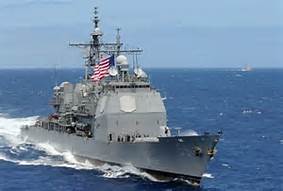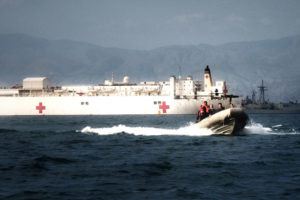The US Navy: Are the Oceans Reaching a Boiling Point?

The United States Navy must adapt to overcome several challenges presented by global climate change.
Every day, the United States Navy addresses some of the country’s most pressing security concerns, including global climate change. This phenomenon has created new challenges for how the Navy operates, but thankfully, there are also opportunities if the nation’s sea service can adapt to the changing environment.
In 2009, the Navy established an initiative known as Task Force Climate Change[1] to study the implications of climate change on the Navy’s operations and force structure. The task force identified several factors that could increase tensions among nation states and lead to a greater need for naval force:
- The recession of the Arctic icepack. The retreat of sea ice that has begun to open up previously unnavigable waterways and allow access to large mineral and oil deposits. Unfortunately, these resources may also increase conflict among nations in the Arctic region, which in turn will require a greater naval presence.[2]
- Destruction of fisheries. Oceanographers have already measured a change in the acidity level of the world’s oceans, which ultimately leads to reduced fish populations.[3] As Task Force Climate Change noted, competition for scarce fishing grounds may contribute to increased maritime conflict.
- Increase in dangerous weather. As the intensity and frequency of major storms increases, so will the need to provide a humanitarian response—a key role the Navy plays in delivering relief supplies, medical care, and fresh water.[4]
- Changes to infrastructure. As sea levels rise, the Navy must improve infrastructure situated on shorelines to avoid flooding, and search for alternative energy solutions to reduce its carbon footprint. [5]
- Changes to rainfall. As global weather patterns change and the frequency of droughts become more severe, the likelihood of conflict for access to reliable water supplies increases, further straining the demand for naval forces.[6]
How can the Navy address these challenges? Well for starters, the Navy can find ways to proactively reduce tensions with some of our nation’s likely competitors by entering into agreements that increase cooperation and understanding on the high seas. The United States is not currently a signor of the Convention on the Law of the Sea (CLOS), and is in fact the only member of the United Nations Security Council that has not ratified the treaty.[7] By taking this step, the Navy would join with other countries in adopting a standard that more clearly defines ownership of oil and mineral rights and establishes a code for peaceful conduct within the Arctic region.
The Navy could convert more of its fleet to a sustainable fuel source, such as biodiesel blends, that have been spearheaded by initiatives such as the Great Green Fleet.[8] By switching to biodiesel, not only does the Navy reduce its carbon footprint, but it also gains several operational advantages in terms of fuel supply security, shortening of its supply chain, and the ability to stay at sea longer before refueling.
The Navy should also consider increasing the number of vessels that may be needed to operate in the Arctic or disaster-affected areas. The Navy currently possesses no icebreaker ship[9] capability, and its hospital ships, which form the backbone of the Navy’s medical relief efforts after a humanitarian disaster, currently stands at two.[10]
The Navy should also increase its investment in renewable energy generation through the Navy’s Renewable Energy Policy Office (REPO)[11]. The Navy has committed to sourcing one gigawatt of its energy demand from renewable sources, but synergies could be realized by partnering with its sister services, the Army and Air Force when purchasing contracts for renewable energy. When taken together, the military represent 93% of the entire federal government’s energy requirements. By combining this total service demand into aggregated contracts, the Navy could leverage the bargaining power that results from an economy of scale.
Finally, the Navy should consider the adoption of battery storage for meeting the energy demands of the fleet. Lithium-ion batteries are reducing in size, and though they may not be suited for a shipboard environment, they may be very useful in reducing the peak energy demands of naval installations while at the same time increasing the energy security of the installation.
The challenges associated with addressing climate change are already increasing security concerns on the world’s oceans. If the Navy is to continue to fulfill its mission of defending American interests on the seas, its leadership must take action now to adapt to global climate change.
754 words
[1] U.S. Navy, “Climate Change,” http://greenfleet.dodlive.mil/climate-change, accessed November 2016.
[2] U.S. Navy, “Arctic Roadmap 2014,” http://www.navy.mil/docs/USN_arctic_roadmap.pdf, accessed November 2016.
[3] EPA, “Climate Change Indicators,” https://www.epa.gov/climate-indicators/climate-change-indicators-ocean-acidity, accessed November 2016.
[4] U.S. Navy, “Humanitarian Work and Disaster Relief,” https://www.navy.com/about/mission/humanitarian.html#where, accessed November 2016.
[5] The Washington Examiner, “Top Navy Leader Says Coastal Bases Are At Risk From Rising Sea Levels,” http://www.washingtonexaminer.com/top-navy-leader-says-coastal-bases-are-at-risk-from-rising-sea-levels/article/2605392, accessed November 2016.
[6]Proceedings of the National Academy of Sciences, “Civil Conflict Sensitivity to Growing-Season Drought,”http://www.pnas.org/content/113/44/12391, Nina von Uexkull, Mihai Croicu, Hanne Fjelde, and Halvard Buhaug, August 2016.
[7]Marine Link, “Law of the Sea Challenges,” http://www.marinelink.com/news/challenges-treaty-arctic346524, accessed November 2016.
[8] U.S. Navy, “The Great Green Fleet,” http://greenfleet.dodlive.mil/energy/great-green-fleet/, accessed November 2016.
[9]Navy Times, “US Navy and Coast Guard Need More Icebreakers Now,” https://www.navytimes.com/story/opinion/2016/06/08/us-navy-and-coast-guard-need-more-icebreakers-now/85603456/, accessed November 2016.
[10] U.S. Navy, “Hospital Ships,” https://www.navy.com/about/equipment/vessels/hospital-ships.html, accessed November 2016.
[11] U.S. Navy, “Renewable Energy Program Office,” http://greenfleet.dodlive.mil/energy/repo-3/, accessed November 2016.




Interesting perspective on what Navy can potentially do to address climate change especially about boiling ocean. It reminds me of a broader perspective about climate change that there are ed other complex and potentially topiocs to take into consideration when we are trying to solve climate change, economic, politics, bargaining power among nations, etc. It’s important that we don’t lose sight of the full picture.
Very interesting subject Tom. And surprising facts too, particularly that 93% of the US government’s energy demand is consumed by the military. Whenever I hear of a major technological military challenge, I think back to the Manhattan project, and I’m sure the government is investing heavily in research and development to address climate change contingencies that we don’t hear about. When I studied physics, I knew several people working on a so-called tokamak machine to harness nuclear fusion – the reaction that fuels “main-sequence” stars like our sun. If we could tap into that energy source, it would open a world of possibilities for clean energy and sustainability, as well as weapons risks too unfortunately. Check it out: https://www.iter.org/mach
Thanks Mark, but I actually wrote the Boeing article.
I was on an aircraft carrier for seven months and remember the process of discarding waste. It basically involved dumping it off the back of the ship. I’m a little skeptical of military efforts to combat climate change.
I think minimizing environmental impact by the military is best accomplished through the procurement process. Once the ships, aircraft, and vehicles are in the hands of the operating forces they are going to be utilized according to their needs, whether the design is energy efficient or not, and I don’t see them being upgraded to more sustainable models. However, you could push for low emissions vessels and planes by expressing these priorities to Lockheed Martin, Raytheon, BAE, Northrup Grumman, and so on.
What an interesting subject here. From a big picture standpoint I think people often discuss the negative aspects that global warming will have on the oceans and water level across the planet, but rarely does the average citizen think about the military implications and extra steps and political actions that will have to be taken to mitigate the changes to the naval world.
In response to some of the earlier comments, I have worked in the defense industry for several years, and I know that at the end of the day the US Government (the customer in this case) almost always drives the requirements and specifications of defense contracts. I would love to see the US Government and those defense contractors work together to strive towards more environmentally friendly naval equipment. At the end of the day, the most efficient way to change the behavior of the business is to change the behavior of the customer, and I think the US Government is smart enough to know that it needs to be an educated customer in order work with those businesses to create a more efficient Navy. I look forward to observing this trend in the future.
Fascinating topic, and certainly an issue in which the Navy is taking a leading role vis-a-vis the other services. However, like Tom, I tend to be largely skeptical of the Navy’s current efforts to build a more sustainable fleet. Sustainability seems to be very much an afterthought and implemented in somewhat piecemeal operational improvements rather than in a fundamental, bottom-up manner through the defense procurement process. Chris and Tom are absolutely right in their assessment that changes in this area will require deep coordination between the US Government and defense contractors in developing sustainable Naval equipment, and I think that resolution here is many years in the distance.
I think that the most interesting issue here is the breadth of strategic challenges that the Navy faces as a result of retreating arctic ice. There has been a ton of literature surfacing on this issue, and CSIS in London ran a piece a couple of years ago that I found to be a good overview of some of the long-term implications if you’re interested: https://csis-prod.s3.amazonaws.com/s3fs-public/legacy_files/files/publication/130307_Conley_NewForeignPolFrontier_Web_0.pdf
You bring up a lot or great points, Tom. Having spent most of my time in the Navy in shipbuilding procurement, the decision doesn’t lie with Navy Procurement or even DoD procurement, they lie with Congress and the White House. On top of that, with growing DoD budget constraints, funding for developing a more sustainable fleet falls well below the Pentagon’s desire to maximize our military’s defense capabilities. Defense contractor can point their fingers to the government all they want, but the truth is that the defense lobby works hard to keep business as usual and congressmen and women want to keep their constituents happily employed.
Let’s also not forget that the Navy is basically holding up the US nuclear vendor base on its own. Without the Navy, I’m not sure the US would be able to shift back building more commercial nuclear power plant if it wanted to.
I tend to side with those who are pessimistic in the Navy’s approach to climate change. Although I agree with your assertion that the Navy needs to consider the implications of climate change, in the current geopolitical environment, I think the Navy cannot reasonably be expected to contribute substantial R&D costs to clean energy alternatives. Although Climate Change is important, it is nowhere near the largest existential threat to our national security.
In 2011 the Budget Control Act (BCA) went into effect and immediately cut funding to discretionary spending, of which the Defense Department falls, by 10% and stays at reduced levels until ~2021 (https://www.ncsha.org/resource/budget-control-act-2011-one-page-summary). The Defense Budgets, which are submitted by the President and approved by Congress, have to keep as much military capability in tact while absorbing the massive budget reduction. This environment, coupled with an increasingly hostile and volatile geopolitical environment, makes allocating funds to climate change technologies difficult, if not impossible. For example, the Navy assessed it needs 48 submarines to meet it’s national security objectives, but in the mid 2020’s will be short by ~8 submarines according to the current shipbuilding plan (https://news.usni.org/2016/03/08/navy-finds-urgency-in-staving-off-a-sub-shortfall-decades-in-the-making). Under these conditions, it’s difficult to make a case for Climate Change technologies when the Navy can’t meet the mission requests of its leaders.